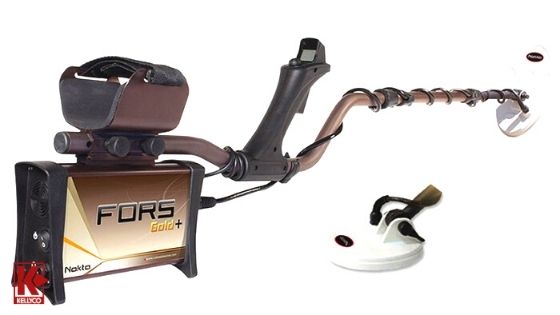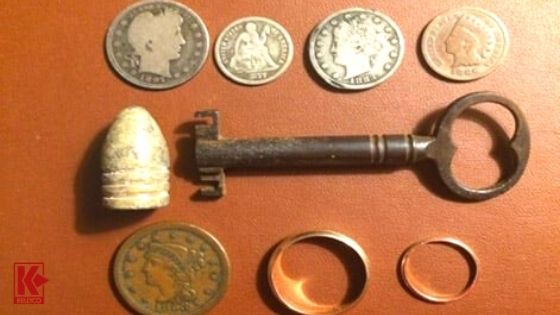Field Test: Nokta Makro FORS Gold+ Metal Detector Review
Published by Colonel Dan on 07/30/19
Purpose :

Nokta Makro FORS Gold+
Test the operational capability and sensitivity at depth in soil and wet salt sand as well as its ability to discriminate and separate good targets from iron on land.
Procedure : All tests conducted, observations and comments reported are from the standpoint of the average user and not a professional design engineer.
After familiarizing myself with the detector by reading the manual in conjunction with the machine itself, tests were designed to evaluate sensitivity at depth in Soil, Wet Salt Sand (WSS) and its ability to Discriminate and Separate (D/S) good targets from iron on land.
WSS and Soil : The Nokta FORS Relic was operated in soil and wet salt sand to determine stability and sensitivity. Sensitivity was determined by reporting the greatest depth at which targets of various size and metallurgical composition could be reliably detected.
D/S : Conducted on land, an iron key was moved incrementally closer to the target so as to determine the closest distance wherein the detector could distinguish between the iron key and the good target.
In all test environments, I used the stock 7”x11” and 5” round coils. I began each round of tests by ground balancing and the menus were set in their factory default positions with the exception of sensitivity which was adjusted to suit the environment. From that baseline, adjustments were made to maximize performance.
I thought it uniquely appropriate that the test targets selected were of the “relic period” and in keeping with the design purpose of the Nokta FORS Gold metal detector.

Relic Field Test
- *1897 Silver Quarter
- *1877 Silver Dime
- *1883 V Nickel
- *1886 Indian Cent
- *Civil War Bullet
- *Antique Key
- *1853 Large Cent
- *14K Wedding Band
- *10K Pinky Ring
Findings : Numerical results are reported on page 3 with observations and concluding comments directly below. As with any detector undergoing field testing, the results reflect and are dependent upon the specific test environment, targets and mineralization in the soil, sand and water. Results of similar tests conducted under different conditions can be expected to differ.
Observations : The Nokta FORS Gold is a well balanced machine that successfully “hides” it 3.9 lbs by placing the control box directly under the elbow—it therefore feels much lighter due to its exceptional balance. The Relic provides a good choice of search modes for practically all environments: GEN(all metal), Di2(2 tone), Di3(3 tone), COG(conductive ground for the beach), DEP (Deep) for deeper target detection and SWT (Swift) for faster recovery and better separation of multiple targets. All modes are easily accessible and tailorable to suit a wide array of environmental conditions.
I found the FORS Relic to be a very good land machine for its intended purpose of relic hunting. It was very easy to successfully and effectively ground balance in auto, manual and ground tracking modes. Although the depth was commensurate with other machines in its category, the separation capability is where this detector shines—particularly with the 5 inch round coil. The FORS Relic was able to distinguish between an antique iron key and other targets even with the key on top of the good target–see data sheet below. The VDI and depth indicator were consistent and acceptably accurate. It also affords two other useful functions with ID Masking to reject select junk targets and adjustable tone breaks making target tone ID customizable and thus easier.
All controls were intuitive and easily manipulated. I particularly appreciated the supplemental display of ground balance, VDI and depth indicator on the handle so I wasn’t forced to rotate the machine in order to view the main screen located under my elbow and on the left side of the control box. The main screen location is easily accessed for right hand swing but for left handers, one must either view the screen upside down or switch hands. With some Internet research, I discovered that Nokta does offer a left hand version available via special order.
Although not designed as a salt water machine, I took the Relic to Cocoa Beach just to see how it would do in the wet salt sand and surf.

Covered By Seawater
I found that with proper ground balance and sensitivity management, I was able to stabilize it but depth suffered in the mineralized environment compared to my land tests—see data sheet below. The best I could do was a quarter at 7 inches in very wet salt sand—not bad for a machine out of its element! The surf was a different story however. Although the coil is water proof, the Relic went into intermittent overload when covered by a few inches of seawater—not unexpected as the FORS Relic wasn’t designed to be a salt water detector.
Conclusions : The Nokta FORS Gold is a good performer in its element when used for its intended purpose. Normally, relic hunters must contend with areas strewn with undesirable targets inter-mixed with the good ones. This is where the Relic earns its keep. The separation capability was excellent with both tested coils but the 5 inch was exceptional. The recovery speed in SWT mode enhanced the separation capability significantly with all tested targets shown above. I would say the Nokta FORS Gold is a solid competitor in its price range for those interested in uncovering relics on land.
My few reservations with the Relic : I would immediately replace the headphones. There are much better ones on the market these days! Secondly, since metal detecting is an outdoor sport, I feel our machines should be at least weather proof. Control box damage due to rain could easily and should be avoided. Finally, a separate version for left hand swing is an unnecessary market shortcoming in my view. All other competitive machines that I know of are ambidextrous… and should be.
| Sensitivity at Depth | 7×11″ Stock | 5″ Round | ||
|---|---|---|---|---|
| Values = inches | WSS | Soil | WSS | Soil |
| 1897 Silver Quarter | 7 | 11 | 4 | 7 |
| 1877 Silver Dime | 7 | 8 | 4 | 6 |
| 1883 V Nickel | 7 | 10 | 3 | 6 |
| 1886 Indian Cent | 5 | 7 | 4 | 6 |
| 3 Ring CW Bullet | 6 | 10 | 3 | 6 |
| Antique Key | 6 | 12 | 4 | 7 |
| 1853 Large Cent | 5 | 11 | 5 | 8 |
| 14K Ring | 5 | 10 | 4 | 8 |
| 10K Ring | 3 | 6 | 2 | 6 |
WWS : 7×11″ ground balances in GEN mode; detection in COG mode. Antique Key detectable in GEN mode.
5″ round coil – Antique Key detectable in DEP. Other targets detectable in GEN mode.
Soil : Ground balanced in GEN mode; DEP mode used in all cases for best depth.
| Separation | 7×11″ Stock | 5″ Round | ||
|---|---|---|---|---|
| Values = inches | H | V | H | V |
| 1897 Silver Quarter | 0.5 | 0.5 | 0 | 0 |
| 1877 Silver Dime | 0.5 | 0.5 | 0 | 0 |
| 1883 V Nickel | 0.5 | 0.5 | 0 | 0 |
| 1886 Indian Cent | 0.5 | 0.5 | 0 | 0 |
| 3 Ring CW Bullet | 0.5 | 0.5 | 0 | 0 |
| 1853 Large Cent | 0.5 | 0.5 | 0 | 0 |
| 14K Ring | 0.5 | 0 | 0 | 0 |
| 10K Ring | 3 | 2 | 0 | 0 |
Closest distance with distinguishable separation between key and good target.
Key orientation relative to the direction of the coil sweep :
- * H=Horizontal (parallel) V=Vertical (perpendicular)
- * 0 = Good target detected with key on top
- * X = Good target not detected; Completely masked
- * 0.5 = Good target detected with key < 0.5 inches from target
- * SWT Mode was most successful for recovery speed and maximum separation
